Health and Safety: Policies, Risk Assessment in Health & Social Care
VerifiedAdded on 2024/05/31
|16
|4388
|152
Report
AI Summary
This report comprehensively addresses health and safety within the health and social care workplace, focusing on the implementation of health and safety legislation, responsibilities within the North Staffordshire NHS Trust, and health and safety priorities for elderly services. It analyzes the impact of risk assessments on care planning for bariatric patients, the effects of health and safety policies on lifting and handling practices, and potential dilemmas faced by care workers. The report also examines the consequences of non-compliance with health and safety legislation, methods for monitoring and reviewing health and safety practices, and the promotion of a positive health and safety culture. The study concludes by evaluating the contribution to prioritizing the health and safety needs of individuals in practice. The document emphasizes the importance of communication, risk assessment, and adherence to safety protocols to ensure a safe and supportive environment for both patients and practitioners.
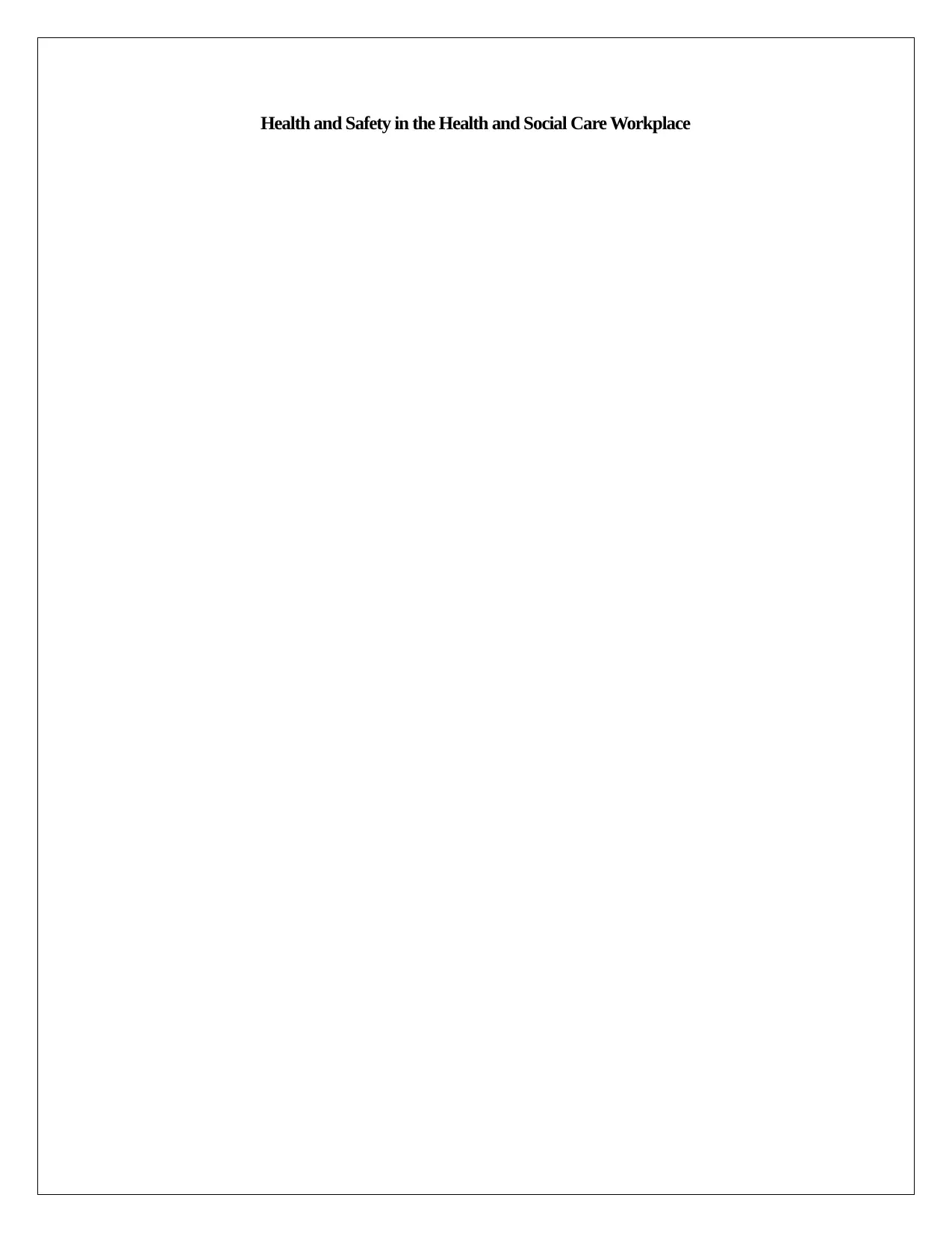
Health and Safety in the Health and Social Care Workplace
Paraphrase This Document
Need a fresh take? Get an instant paraphrase of this document with our AI Paraphraser
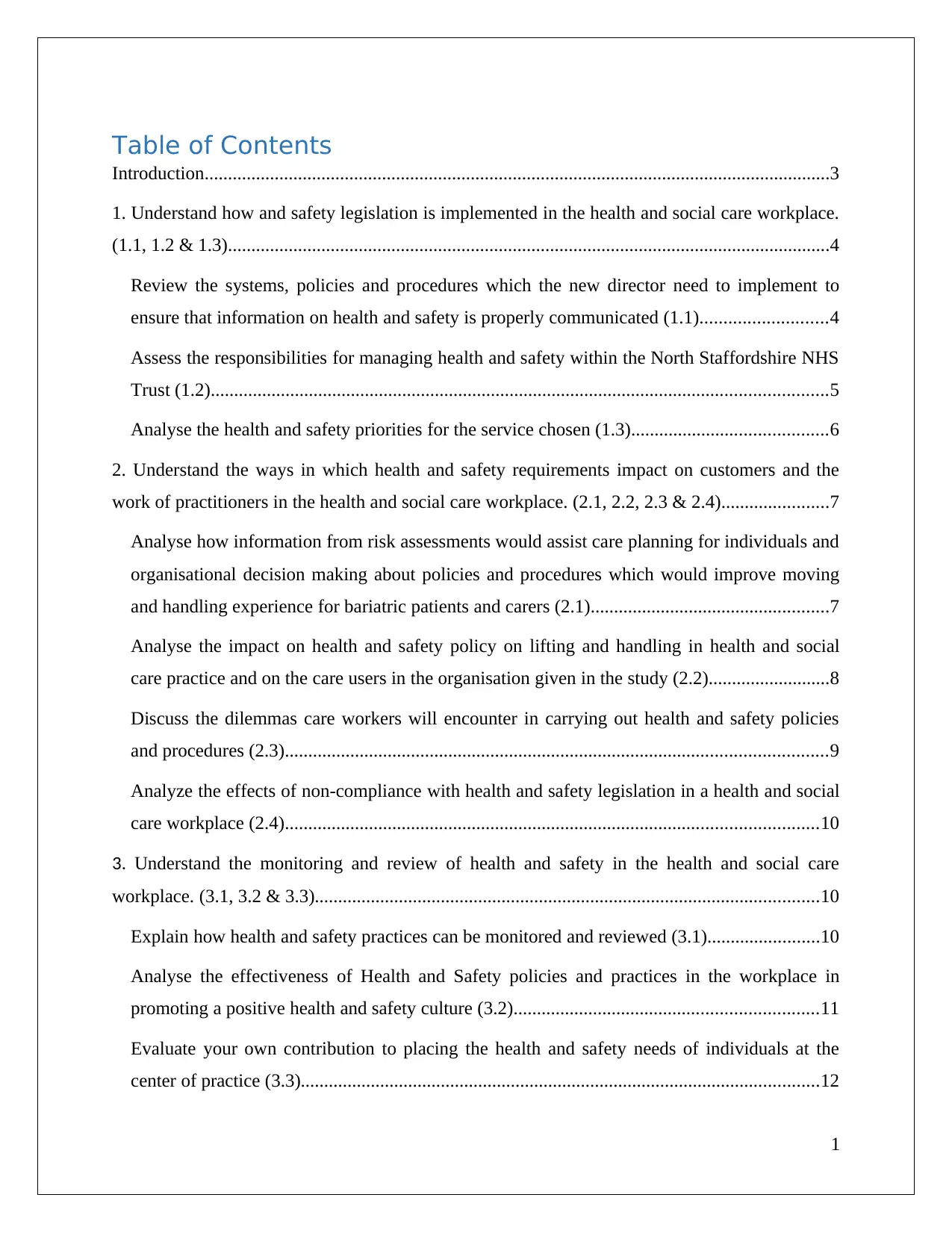
Table of Contents
Introduction......................................................................................................................................3
1. Understand how and safety legislation is implemented in the health and social care workplace.
(1.1, 1.2 & 1.3).................................................................................................................................4
Review the systems, policies and procedures which the new director need to implement to
ensure that information on health and safety is properly communicated (1.1)...........................4
Assess the responsibilities for managing health and safety within the North Staffordshire NHS
Trust (1.2)....................................................................................................................................5
Analyse the health and safety priorities for the service chosen (1.3)..........................................6
2. Understand the ways in which health and safety requirements impact on customers and the
work of practitioners in the health and social care workplace. (2.1, 2.2, 2.3 & 2.4).......................7
Analyse how information from risk assessments would assist care planning for individuals and
organisational decision making about policies and procedures which would improve moving
and handling experience for bariatric patients and carers (2.1)...................................................7
Analyse the impact on health and safety policy on lifting and handling in health and social
care practice and on the care users in the organisation given in the study (2.2)..........................8
Discuss the dilemmas care workers will encounter in carrying out health and safety policies
and procedures (2.3)....................................................................................................................9
Analyze the effects of non-compliance with health and safety legislation in a health and social
care workplace (2.4)..................................................................................................................10
3. Understand the monitoring and review of health and safety in the health and social care
workplace. (3.1, 3.2 & 3.3)............................................................................................................10
Explain how health and safety practices can be monitored and reviewed (3.1)........................10
Analyse the effectiveness of Health and Safety policies and practices in the workplace in
promoting a positive health and safety culture (3.2).................................................................11
Evaluate your own contribution to placing the health and safety needs of individuals at the
center of practice (3.3)...............................................................................................................12
1
Introduction......................................................................................................................................3
1. Understand how and safety legislation is implemented in the health and social care workplace.
(1.1, 1.2 & 1.3).................................................................................................................................4
Review the systems, policies and procedures which the new director need to implement to
ensure that information on health and safety is properly communicated (1.1)...........................4
Assess the responsibilities for managing health and safety within the North Staffordshire NHS
Trust (1.2)....................................................................................................................................5
Analyse the health and safety priorities for the service chosen (1.3)..........................................6
2. Understand the ways in which health and safety requirements impact on customers and the
work of practitioners in the health and social care workplace. (2.1, 2.2, 2.3 & 2.4).......................7
Analyse how information from risk assessments would assist care planning for individuals and
organisational decision making about policies and procedures which would improve moving
and handling experience for bariatric patients and carers (2.1)...................................................7
Analyse the impact on health and safety policy on lifting and handling in health and social
care practice and on the care users in the organisation given in the study (2.2)..........................8
Discuss the dilemmas care workers will encounter in carrying out health and safety policies
and procedures (2.3)....................................................................................................................9
Analyze the effects of non-compliance with health and safety legislation in a health and social
care workplace (2.4)..................................................................................................................10
3. Understand the monitoring and review of health and safety in the health and social care
workplace. (3.1, 3.2 & 3.3)............................................................................................................10
Explain how health and safety practices can be monitored and reviewed (3.1)........................10
Analyse the effectiveness of Health and Safety policies and practices in the workplace in
promoting a positive health and safety culture (3.2).................................................................11
Evaluate your own contribution to placing the health and safety needs of individuals at the
center of practice (3.3)...............................................................................................................12
1
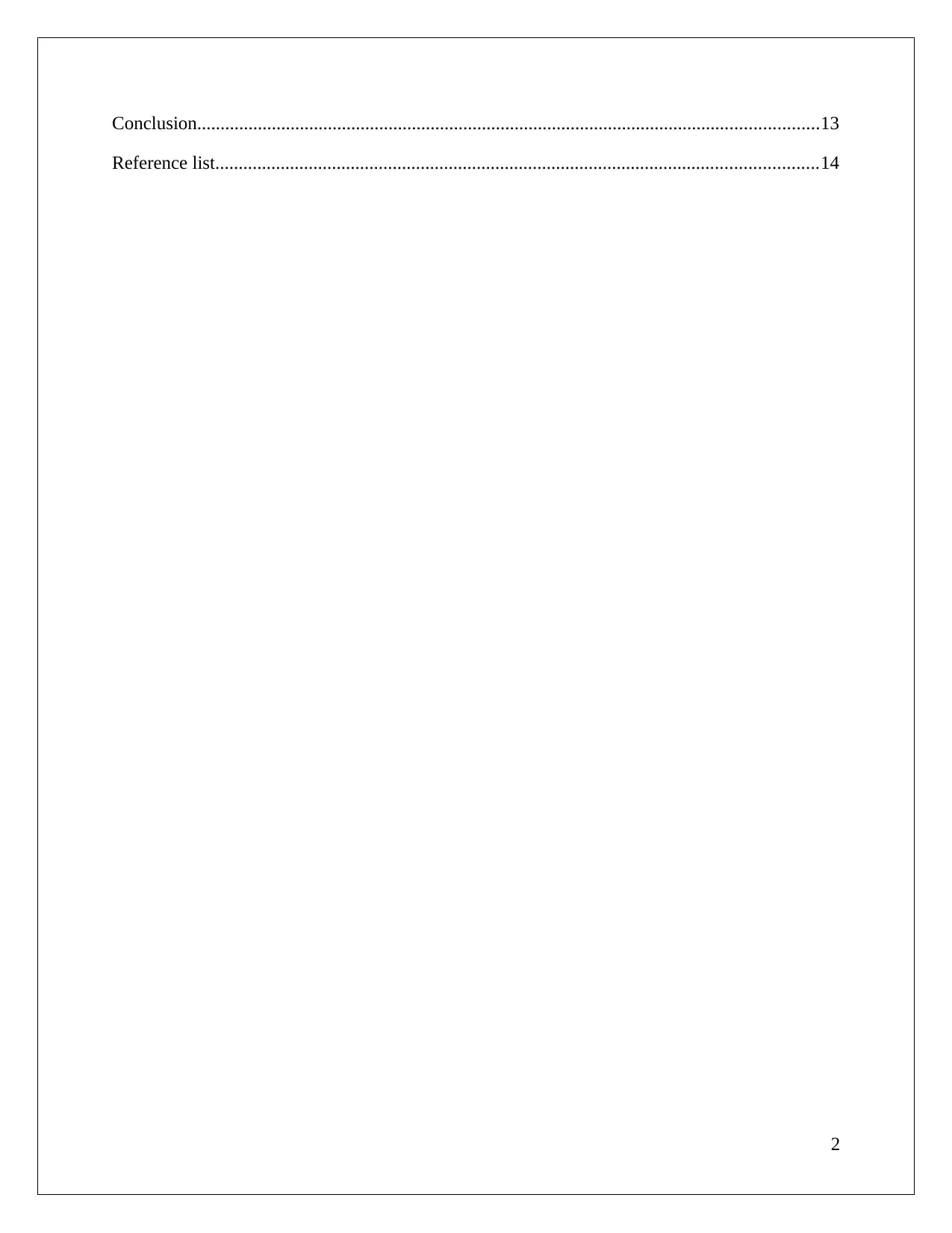
Conclusion.....................................................................................................................................13
Reference list.................................................................................................................................14
2
Reference list.................................................................................................................................14
2
⊘ This is a preview!⊘
Do you want full access?
Subscribe today to unlock all pages.

Trusted by 1+ million students worldwide
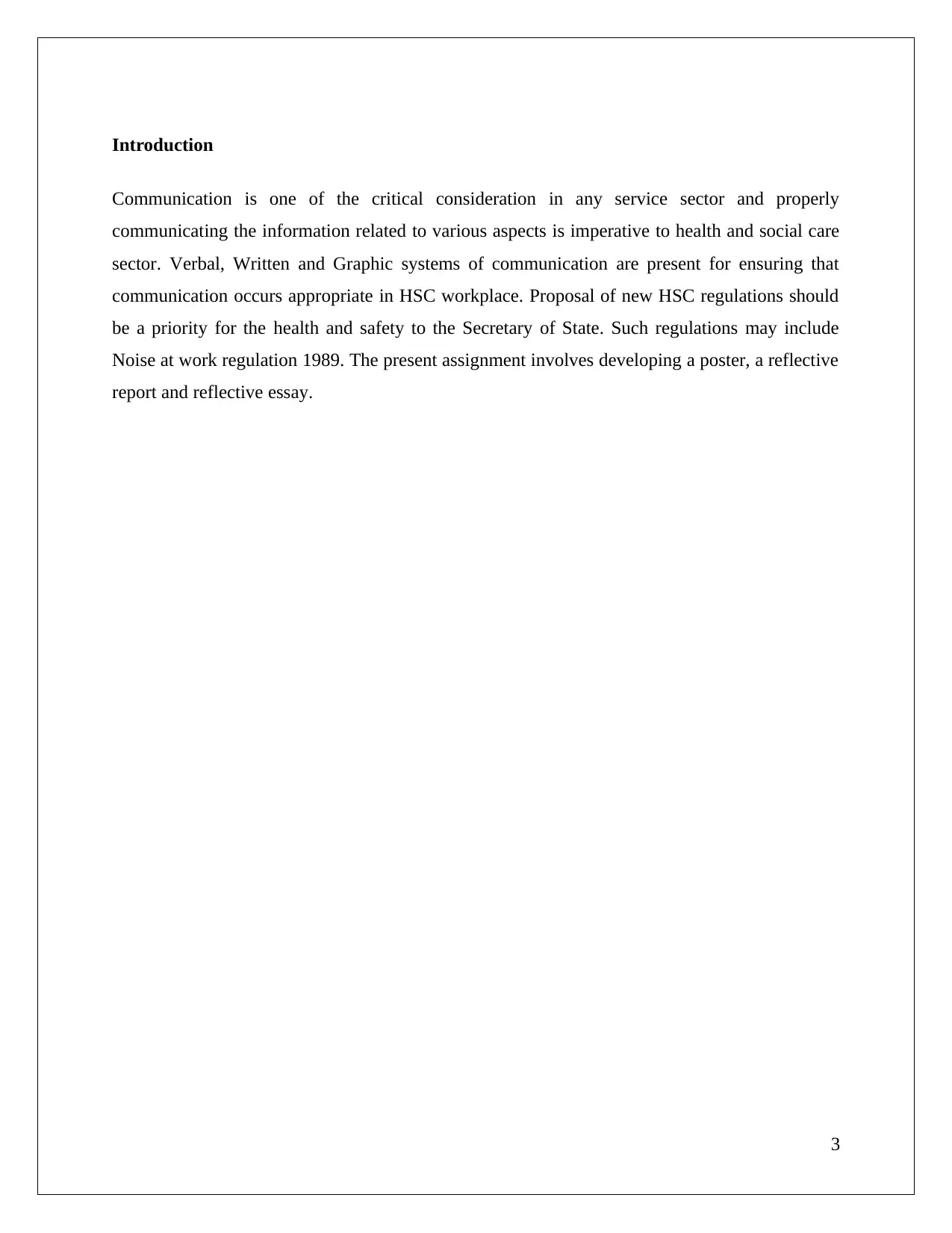
Introduction
Communication is one of the critical consideration in any service sector and properly
communicating the information related to various aspects is imperative to health and social care
sector. Verbal, Written and Graphic systems of communication are present for ensuring that
communication occurs appropriate in HSC workplace. Proposal of new HSC regulations should
be a priority for the health and safety to the Secretary of State. Such regulations may include
Noise at work regulation 1989. The present assignment involves developing a poster, a reflective
report and reflective essay.
3
Communication is one of the critical consideration in any service sector and properly
communicating the information related to various aspects is imperative to health and social care
sector. Verbal, Written and Graphic systems of communication are present for ensuring that
communication occurs appropriate in HSC workplace. Proposal of new HSC regulations should
be a priority for the health and safety to the Secretary of State. Such regulations may include
Noise at work regulation 1989. The present assignment involves developing a poster, a reflective
report and reflective essay.
3
Paraphrase This Document
Need a fresh take? Get an instant paraphrase of this document with our AI Paraphraser
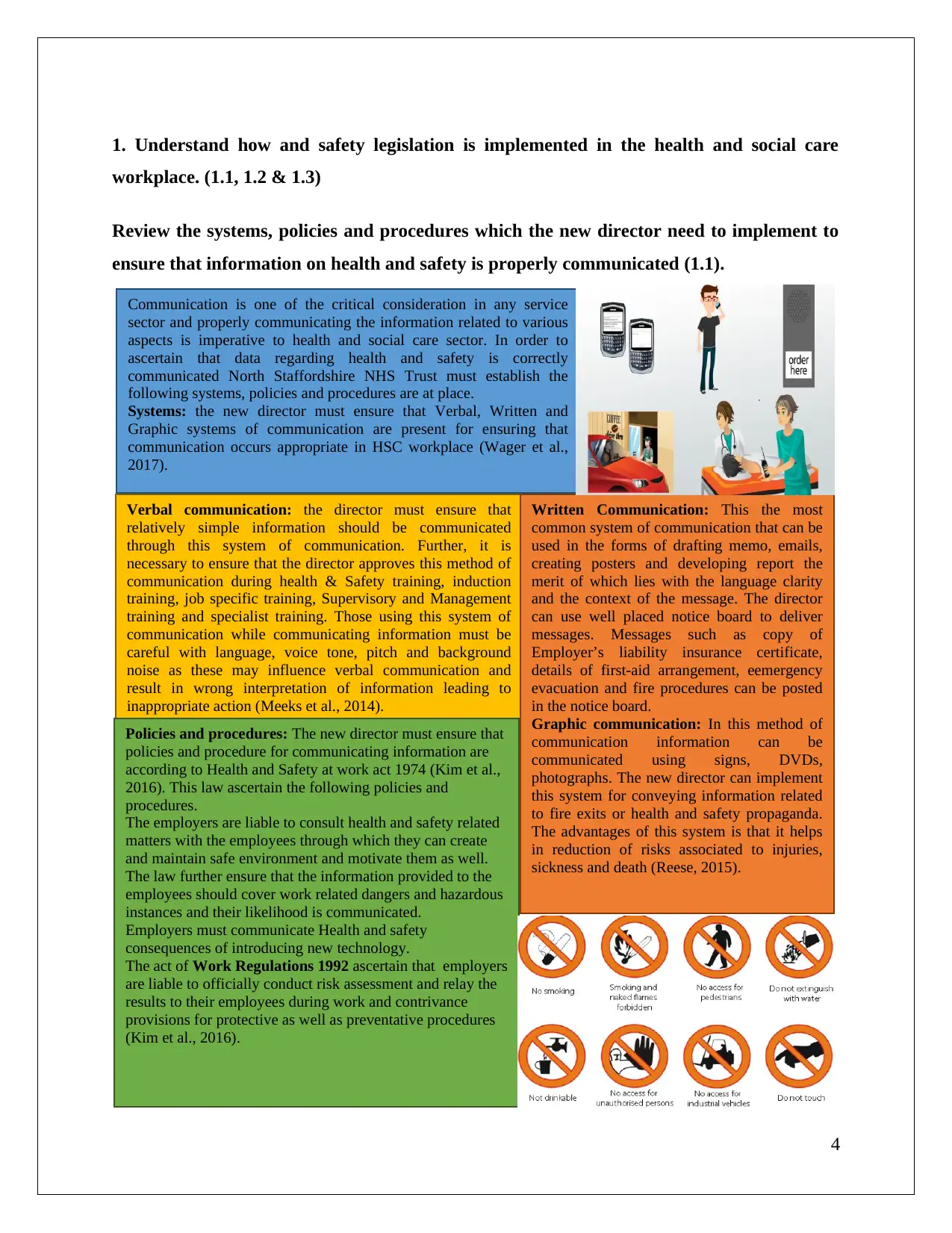
Communication is one of the critical consideration in any service
sector and properly communicating the information related to various
aspects is imperative to health and social care sector. In order to
ascertain that data regarding health and safety is correctly
communicated North Staffordshire NHS Trust must establish the
following systems, policies and procedures are at place.
Systems: the new director must ensure that Verbal, Written and
Graphic systems of communication are present for ensuring that
communication occurs appropriate in HSC workplace (Wager et al.,
2017).
Verbal communication: the director must ensure that
relatively simple information should be communicated
through this system of communication. Further, it is
necessary to ensure that the director approves this method of
communication during health & Safety training, induction
training, job specific training, Supervisory and Management
training and specialist training. Those using this system of
communication while communicating information must be
careful with language, voice tone, pitch and background
noise as these may influence verbal communication and
result in wrong interpretation of information leading to
inappropriate action (Meeks et al., 2014).
Written Communication: This the most
common system of communication that can be
used in the forms of drafting memo, emails,
creating posters and developing report the
merit of which lies with the language clarity
and the context of the message. The director
can use well placed notice board to deliver
messages. Messages such as copy of
Employer’s liability insurance certificate,
details of first-aid arrangement, eemergency
evacuation and fire procedures can be posted
in the notice board.
Graphic communication: In this method of
communication information can be
communicated using signs, DVDs,
photographs. The new director can implement
this system for conveying information related
to fire exits or health and safety propaganda.
The advantages of this system is that it helps
in reduction of risks associated to injuries,
sickness and death (Reese, 2015).
Policies and procedures: The new director must ensure that
policies and procedure for communicating information are
according to Health and Safety at work act 1974 (Kim et al.,
2016). This law ascertain the following policies and
procedures.
The employers are liable to consult health and safety related
matters with the employees through which they can create
and maintain safe environment and motivate them as well.
The law further ensure that the information provided to the
employees should cover work related dangers and hazardous
instances and their likelihood is communicated.
Employers must communicate Health and safety
consequences of introducing new technology.
The act of Work Regulations 1992 ascertain that employers
are liable to officially conduct risk assessment and relay the
results to their employees during work and contrivance
provisions for protective as well as preventative procedures
(Kim et al., 2016).
1. Understand how and safety legislation is implemented in the health and social care
workplace. (1.1, 1.2 & 1.3)
Review the systems, policies and procedures which the new director need to implement to
ensure that information on health and safety is properly communicated (1.1).
4
sector and properly communicating the information related to various
aspects is imperative to health and social care sector. In order to
ascertain that data regarding health and safety is correctly
communicated North Staffordshire NHS Trust must establish the
following systems, policies and procedures are at place.
Systems: the new director must ensure that Verbal, Written and
Graphic systems of communication are present for ensuring that
communication occurs appropriate in HSC workplace (Wager et al.,
2017).
Verbal communication: the director must ensure that
relatively simple information should be communicated
through this system of communication. Further, it is
necessary to ensure that the director approves this method of
communication during health & Safety training, induction
training, job specific training, Supervisory and Management
training and specialist training. Those using this system of
communication while communicating information must be
careful with language, voice tone, pitch and background
noise as these may influence verbal communication and
result in wrong interpretation of information leading to
inappropriate action (Meeks et al., 2014).
Written Communication: This the most
common system of communication that can be
used in the forms of drafting memo, emails,
creating posters and developing report the
merit of which lies with the language clarity
and the context of the message. The director
can use well placed notice board to deliver
messages. Messages such as copy of
Employer’s liability insurance certificate,
details of first-aid arrangement, eemergency
evacuation and fire procedures can be posted
in the notice board.
Graphic communication: In this method of
communication information can be
communicated using signs, DVDs,
photographs. The new director can implement
this system for conveying information related
to fire exits or health and safety propaganda.
The advantages of this system is that it helps
in reduction of risks associated to injuries,
sickness and death (Reese, 2015).
Policies and procedures: The new director must ensure that
policies and procedure for communicating information are
according to Health and Safety at work act 1974 (Kim et al.,
2016). This law ascertain the following policies and
procedures.
The employers are liable to consult health and safety related
matters with the employees through which they can create
and maintain safe environment and motivate them as well.
The law further ensure that the information provided to the
employees should cover work related dangers and hazardous
instances and their likelihood is communicated.
Employers must communicate Health and safety
consequences of introducing new technology.
The act of Work Regulations 1992 ascertain that employers
are liable to officially conduct risk assessment and relay the
results to their employees during work and contrivance
provisions for protective as well as preventative procedures
(Kim et al., 2016).
1. Understand how and safety legislation is implemented in the health and social care
workplace. (1.1, 1.2 & 1.3)
Review the systems, policies and procedures which the new director need to implement to
ensure that information on health and safety is properly communicated (1.1).
4
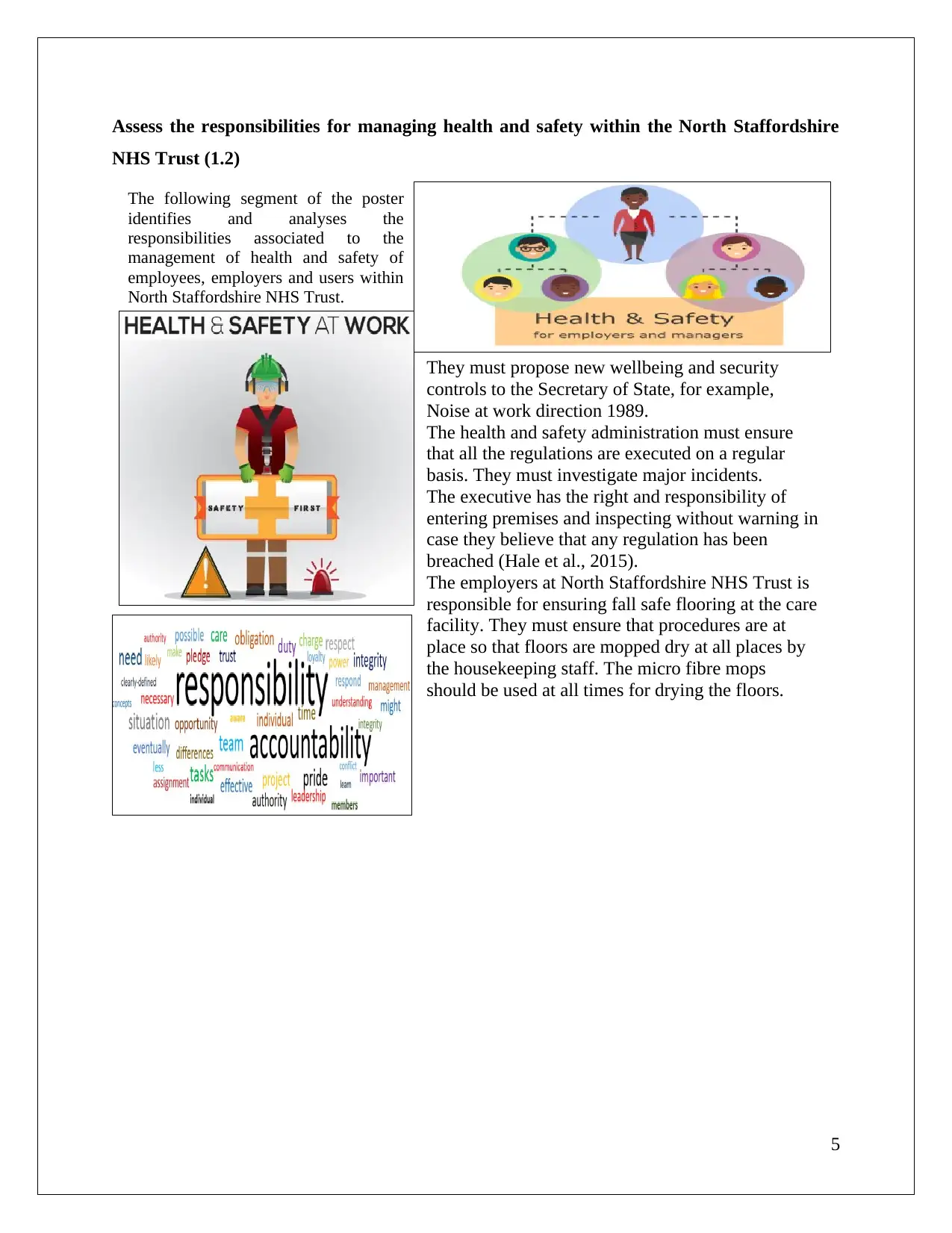
The following segment of the poster
identifies and analyses the
responsibilities associated to the
management of health and safety of
employees, employers and users within
North Staffordshire NHS Trust.
They must propose new wellbeing and security
controls to the Secretary of State, for example,
Noise at work direction 1989.
The health and safety administration must ensure
that all the regulations are executed on a regular
basis. They must investigate major incidents.
The executive has the right and responsibility of
entering premises and inspecting without warning in
case they believe that any regulation has been
breached (Hale et al., 2015).
The employers at North Staffordshire NHS Trust is
responsible for ensuring fall safe flooring at the care
facility. They must ensure that procedures are at
place so that floors are mopped dry at all places by
the housekeeping staff. The micro fibre mops
should be used at all times for drying the floors.
Assess the responsibilities for managing health and safety within the North Staffordshire
NHS Trust (1.2)
5
identifies and analyses the
responsibilities associated to the
management of health and safety of
employees, employers and users within
North Staffordshire NHS Trust.
They must propose new wellbeing and security
controls to the Secretary of State, for example,
Noise at work direction 1989.
The health and safety administration must ensure
that all the regulations are executed on a regular
basis. They must investigate major incidents.
The executive has the right and responsibility of
entering premises and inspecting without warning in
case they believe that any regulation has been
breached (Hale et al., 2015).
The employers at North Staffordshire NHS Trust is
responsible for ensuring fall safe flooring at the care
facility. They must ensure that procedures are at
place so that floors are mopped dry at all places by
the housekeeping staff. The micro fibre mops
should be used at all times for drying the floors.
Assess the responsibilities for managing health and safety within the North Staffordshire
NHS Trust (1.2)
5
⊘ This is a preview!⊘
Do you want full access?
Subscribe today to unlock all pages.

Trusted by 1+ million students worldwide
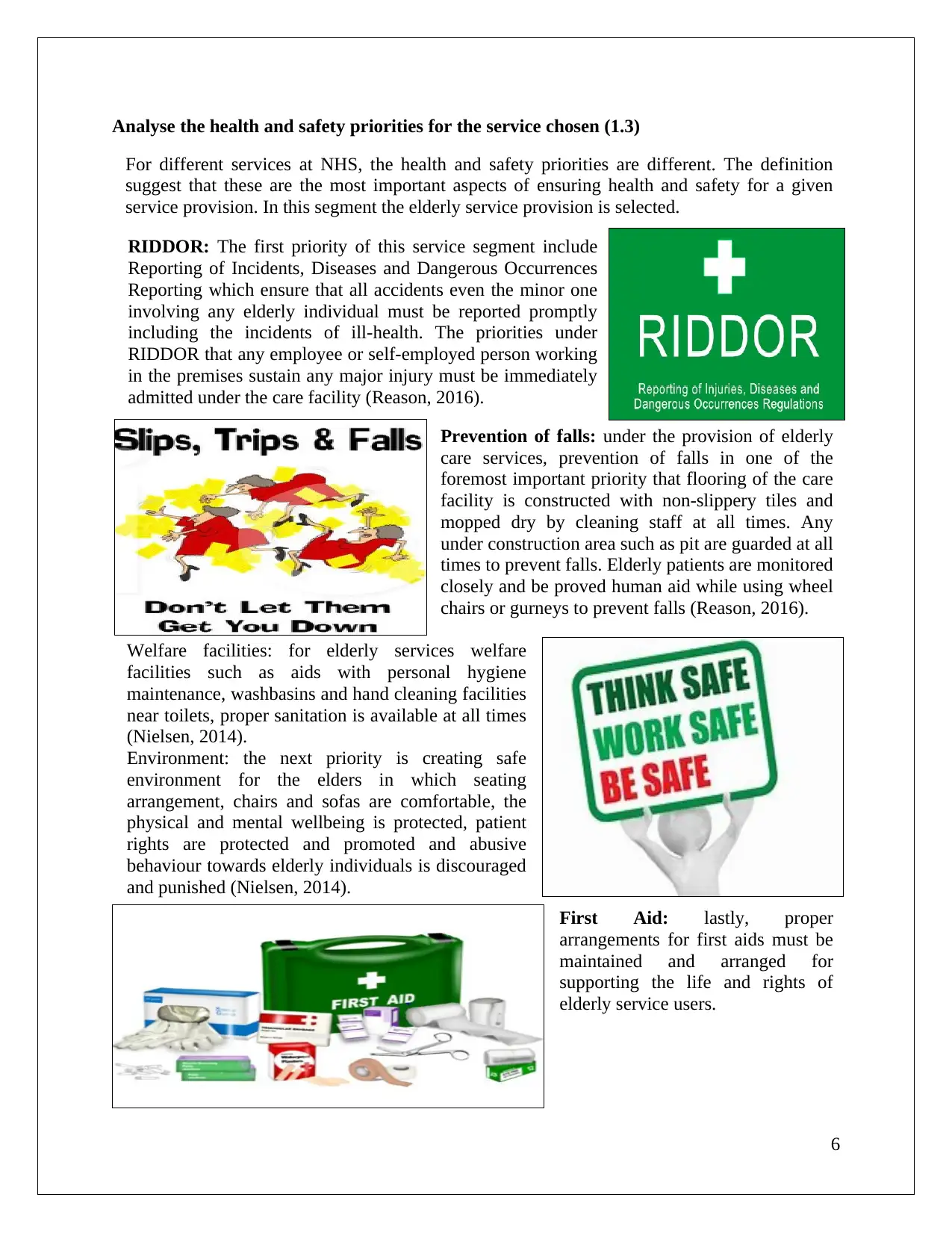
For different services at NHS, the health and safety priorities are different. The definition
suggest that these are the most important aspects of ensuring health and safety for a given
service provision. In this segment the elderly service provision is selected.
RIDDOR: The first priority of this service segment include
Reporting of Incidents, Diseases and Dangerous Occurrences
Reporting which ensure that all accidents even the minor one
involving any elderly individual must be reported promptly
including the incidents of ill-health. The priorities under
RIDDOR that any employee or self-employed person working
in the premises sustain any major injury must be immediately
admitted under the care facility (Reason, 2016).
Prevention of falls: under the provision of elderly
care services, prevention of falls in one of the
foremost important priority that flooring of the care
facility is constructed with non-slippery tiles and
mopped dry by cleaning staff at all times. Any
under construction area such as pit are guarded at all
times to prevent falls. Elderly patients are monitored
closely and be proved human aid while using wheel
chairs or gurneys to prevent falls (Reason, 2016).
Welfare facilities: for elderly services welfare
facilities such as aids with personal hygiene
maintenance, washbasins and hand cleaning facilities
near toilets, proper sanitation is available at all times
(Nielsen, 2014).
Environment: the next priority is creating safe
environment for the elders in which seating
arrangement, chairs and sofas are comfortable, the
physical and mental wellbeing is protected, patient
rights are protected and promoted and abusive
behaviour towards elderly individuals is discouraged
and punished (Nielsen, 2014).
First Aid: lastly, proper
arrangements for first aids must be
maintained and arranged for
supporting the life and rights of
elderly service users.
Analyse the health and safety priorities for the service chosen (1.3)
6
suggest that these are the most important aspects of ensuring health and safety for a given
service provision. In this segment the elderly service provision is selected.
RIDDOR: The first priority of this service segment include
Reporting of Incidents, Diseases and Dangerous Occurrences
Reporting which ensure that all accidents even the minor one
involving any elderly individual must be reported promptly
including the incidents of ill-health. The priorities under
RIDDOR that any employee or self-employed person working
in the premises sustain any major injury must be immediately
admitted under the care facility (Reason, 2016).
Prevention of falls: under the provision of elderly
care services, prevention of falls in one of the
foremost important priority that flooring of the care
facility is constructed with non-slippery tiles and
mopped dry by cleaning staff at all times. Any
under construction area such as pit are guarded at all
times to prevent falls. Elderly patients are monitored
closely and be proved human aid while using wheel
chairs or gurneys to prevent falls (Reason, 2016).
Welfare facilities: for elderly services welfare
facilities such as aids with personal hygiene
maintenance, washbasins and hand cleaning facilities
near toilets, proper sanitation is available at all times
(Nielsen, 2014).
Environment: the next priority is creating safe
environment for the elders in which seating
arrangement, chairs and sofas are comfortable, the
physical and mental wellbeing is protected, patient
rights are protected and promoted and abusive
behaviour towards elderly individuals is discouraged
and punished (Nielsen, 2014).
First Aid: lastly, proper
arrangements for first aids must be
maintained and arranged for
supporting the life and rights of
elderly service users.
Analyse the health and safety priorities for the service chosen (1.3)
6
Paraphrase This Document
Need a fresh take? Get an instant paraphrase of this document with our AI Paraphraser
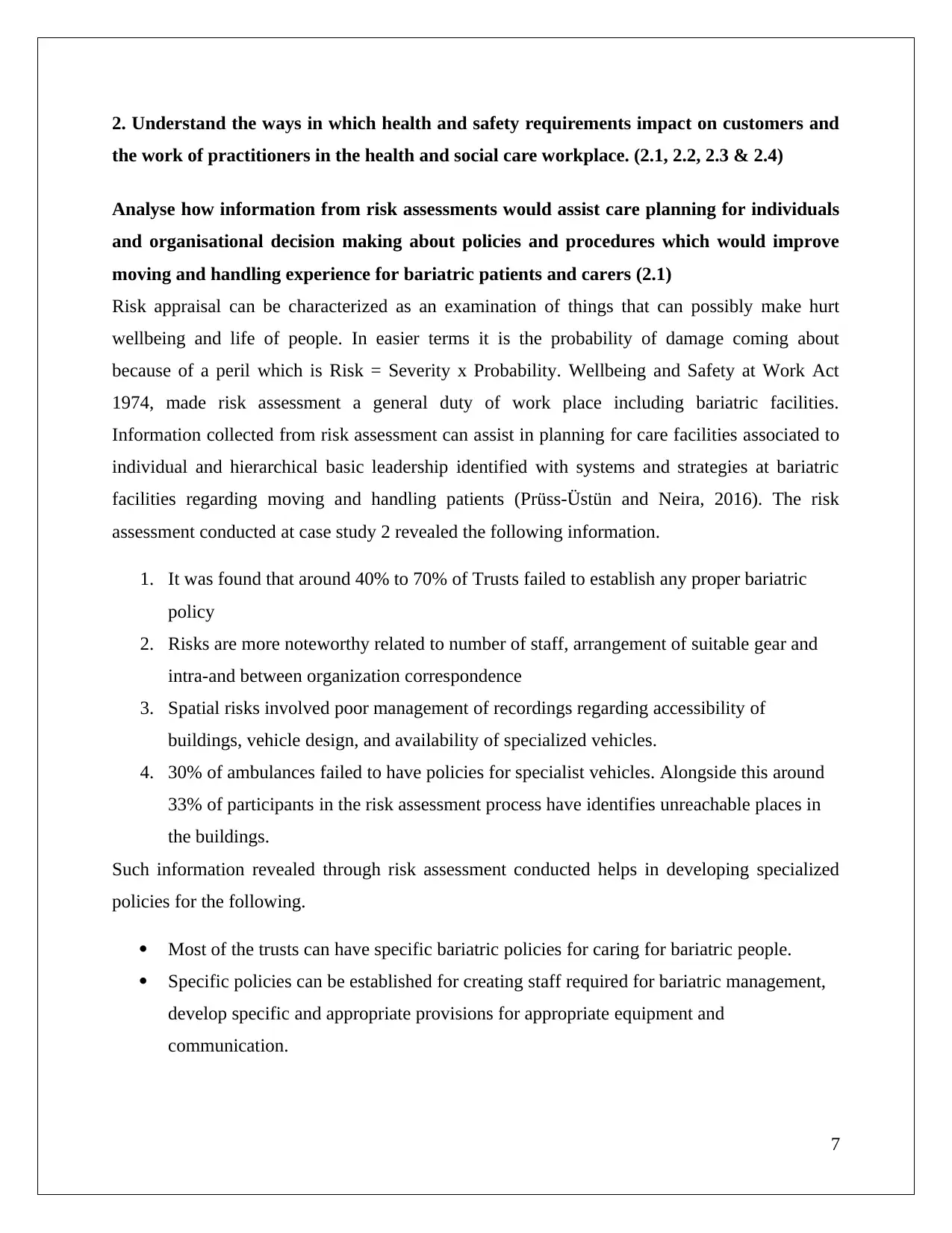
2. Understand the ways in which health and safety requirements impact on customers and
the work of practitioners in the health and social care workplace. (2.1, 2.2, 2.3 & 2.4)
Analyse how information from risk assessments would assist care planning for individuals
and organisational decision making about policies and procedures which would improve
moving and handling experience for bariatric patients and carers (2.1)
Risk appraisal can be characterized as an examination of things that can possibly make hurt
wellbeing and life of people. In easier terms it is the probability of damage coming about
because of a peril which is Risk = Severity x Probability. Wellbeing and Safety at Work Act
1974, made risk assessment a general duty of work place including bariatric facilities.
Information collected from risk assessment can assist in planning for care facilities associated to
individual and hierarchical basic leadership identified with systems and strategies at bariatric
facilities regarding moving and handling patients (Prüss-Üstün and Neira, 2016). The risk
assessment conducted at case study 2 revealed the following information.
1. It was found that around 40% to 70% of Trusts failed to establish any proper bariatric
policy
2. Risks are more noteworthy related to number of staff, arrangement of suitable gear and
intra-and between organization correspondence
3. Spatial risks involved poor management of recordings regarding accessibility of
buildings, vehicle design, and availability of specialized vehicles.
4. 30% of ambulances failed to have policies for specialist vehicles. Alongside this around
33% of participants in the risk assessment process have identifies unreachable places in
the buildings.
Such information revealed through risk assessment conducted helps in developing specialized
policies for the following.
Most of the trusts can have specific bariatric policies for caring for bariatric people.
Specific policies can be established for creating staff required for bariatric management,
develop specific and appropriate provisions for appropriate equipment and
communication.
7
the work of practitioners in the health and social care workplace. (2.1, 2.2, 2.3 & 2.4)
Analyse how information from risk assessments would assist care planning for individuals
and organisational decision making about policies and procedures which would improve
moving and handling experience for bariatric patients and carers (2.1)
Risk appraisal can be characterized as an examination of things that can possibly make hurt
wellbeing and life of people. In easier terms it is the probability of damage coming about
because of a peril which is Risk = Severity x Probability. Wellbeing and Safety at Work Act
1974, made risk assessment a general duty of work place including bariatric facilities.
Information collected from risk assessment can assist in planning for care facilities associated to
individual and hierarchical basic leadership identified with systems and strategies at bariatric
facilities regarding moving and handling patients (Prüss-Üstün and Neira, 2016). The risk
assessment conducted at case study 2 revealed the following information.
1. It was found that around 40% to 70% of Trusts failed to establish any proper bariatric
policy
2. Risks are more noteworthy related to number of staff, arrangement of suitable gear and
intra-and between organization correspondence
3. Spatial risks involved poor management of recordings regarding accessibility of
buildings, vehicle design, and availability of specialized vehicles.
4. 30% of ambulances failed to have policies for specialist vehicles. Alongside this around
33% of participants in the risk assessment process have identifies unreachable places in
the buildings.
Such information revealed through risk assessment conducted helps in developing specialized
policies for the following.
Most of the trusts can have specific bariatric policies for caring for bariatric people.
Specific policies can be established for creating staff required for bariatric management,
develop specific and appropriate provisions for appropriate equipment and
communication.
7
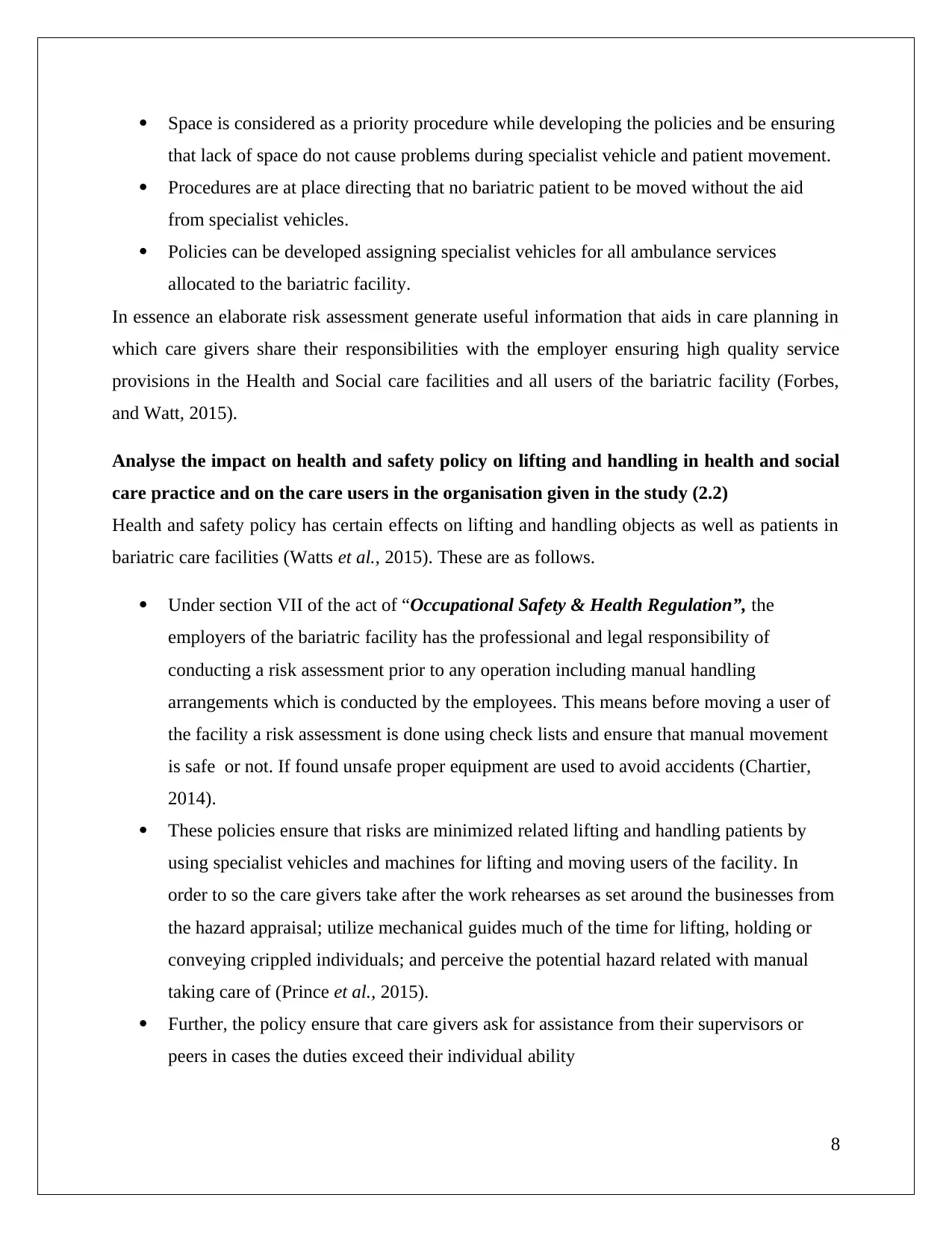
Space is considered as a priority procedure while developing the policies and be ensuring
that lack of space do not cause problems during specialist vehicle and patient movement.
Procedures are at place directing that no bariatric patient to be moved without the aid
from specialist vehicles.
Policies can be developed assigning specialist vehicles for all ambulance services
allocated to the bariatric facility.
In essence an elaborate risk assessment generate useful information that aids in care planning in
which care givers share their responsibilities with the employer ensuring high quality service
provisions in the Health and Social care facilities and all users of the bariatric facility (Forbes,
and Watt, 2015).
Analyse the impact on health and safety policy on lifting and handling in health and social
care practice and on the care users in the organisation given in the study (2.2)
Health and safety policy has certain effects on lifting and handling objects as well as patients in
bariatric care facilities (Watts et al., 2015). These are as follows.
Under section VII of the act of “Occupational Safety & Health Regulation”, the
employers of the bariatric facility has the professional and legal responsibility of
conducting a risk assessment prior to any operation including manual handling
arrangements which is conducted by the employees. This means before moving a user of
the facility a risk assessment is done using check lists and ensure that manual movement
is safe or not. If found unsafe proper equipment are used to avoid accidents (Chartier,
2014).
These policies ensure that risks are minimized related lifting and handling patients by
using specialist vehicles and machines for lifting and moving users of the facility. In
order to so the care givers take after the work rehearses as set around the businesses from
the hazard appraisal; utilize mechanical guides much of the time for lifting, holding or
conveying crippled individuals; and perceive the potential hazard related with manual
taking care of (Prince et al., 2015).
Further, the policy ensure that care givers ask for assistance from their supervisors or
peers in cases the duties exceed their individual ability
8
that lack of space do not cause problems during specialist vehicle and patient movement.
Procedures are at place directing that no bariatric patient to be moved without the aid
from specialist vehicles.
Policies can be developed assigning specialist vehicles for all ambulance services
allocated to the bariatric facility.
In essence an elaborate risk assessment generate useful information that aids in care planning in
which care givers share their responsibilities with the employer ensuring high quality service
provisions in the Health and Social care facilities and all users of the bariatric facility (Forbes,
and Watt, 2015).
Analyse the impact on health and safety policy on lifting and handling in health and social
care practice and on the care users in the organisation given in the study (2.2)
Health and safety policy has certain effects on lifting and handling objects as well as patients in
bariatric care facilities (Watts et al., 2015). These are as follows.
Under section VII of the act of “Occupational Safety & Health Regulation”, the
employers of the bariatric facility has the professional and legal responsibility of
conducting a risk assessment prior to any operation including manual handling
arrangements which is conducted by the employees. This means before moving a user of
the facility a risk assessment is done using check lists and ensure that manual movement
is safe or not. If found unsafe proper equipment are used to avoid accidents (Chartier,
2014).
These policies ensure that risks are minimized related lifting and handling patients by
using specialist vehicles and machines for lifting and moving users of the facility. In
order to so the care givers take after the work rehearses as set around the businesses from
the hazard appraisal; utilize mechanical guides much of the time for lifting, holding or
conveying crippled individuals; and perceive the potential hazard related with manual
taking care of (Prince et al., 2015).
Further, the policy ensure that care givers ask for assistance from their supervisors or
peers in cases the duties exceed their individual ability
8
⊘ This is a preview!⊘
Do you want full access?
Subscribe today to unlock all pages.

Trusted by 1+ million students worldwide
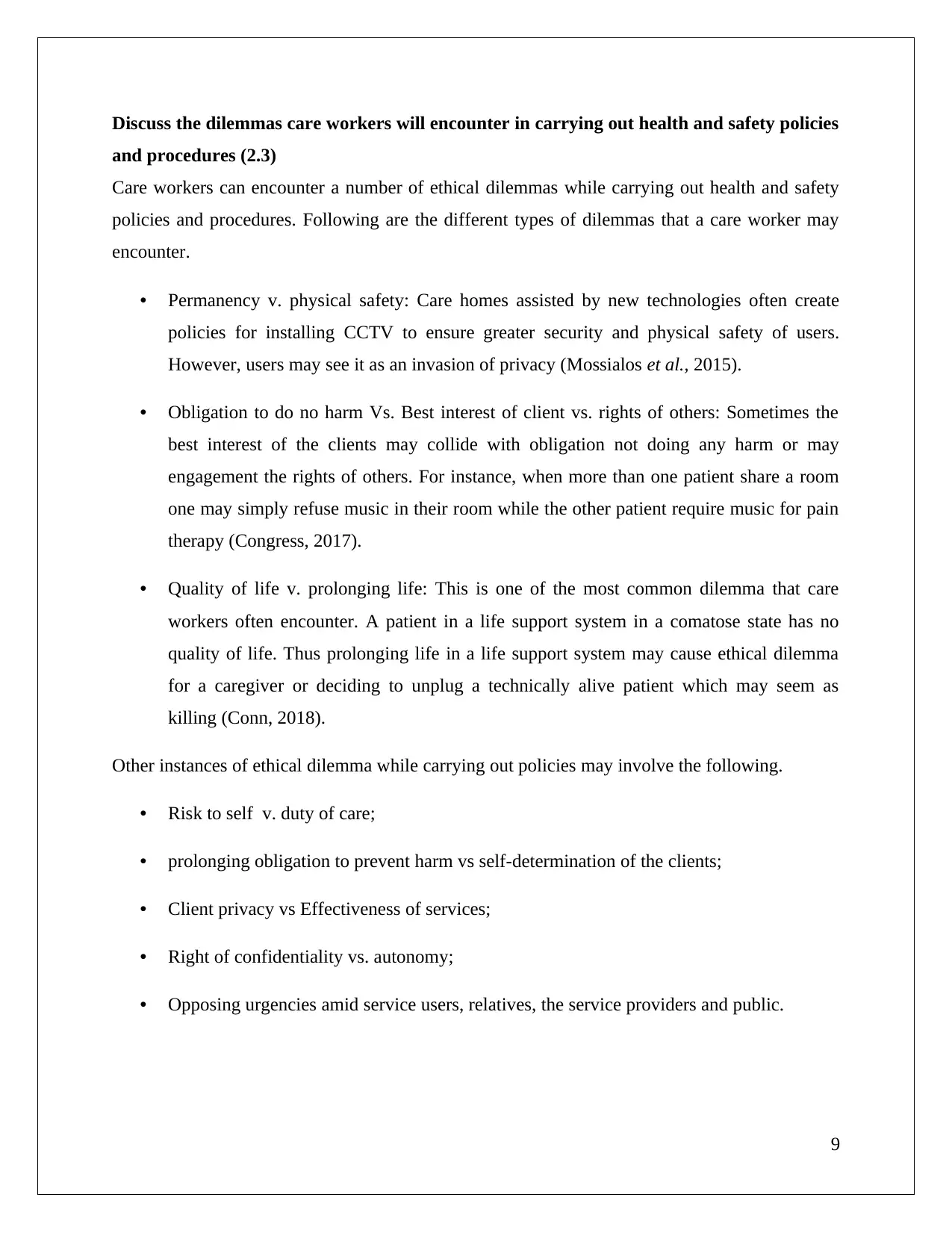
Discuss the dilemmas care workers will encounter in carrying out health and safety policies
and procedures (2.3)
Care workers can encounter a number of ethical dilemmas while carrying out health and safety
policies and procedures. Following are the different types of dilemmas that a care worker may
encounter.
• Permanency v. physical safety: Care homes assisted by new technologies often create
policies for installing CCTV to ensure greater security and physical safety of users.
However, users may see it as an invasion of privacy (Mossialos et al., 2015).
• Obligation to do no harm Vs. Best interest of client vs. rights of others: Sometimes the
best interest of the clients may collide with obligation not doing any harm or may
engagement the rights of others. For instance, when more than one patient share a room
one may simply refuse music in their room while the other patient require music for pain
therapy (Congress, 2017).
• Quality of life v. prolonging life: This is one of the most common dilemma that care
workers often encounter. A patient in a life support system in a comatose state has no
quality of life. Thus prolonging life in a life support system may cause ethical dilemma
for a caregiver or deciding to unplug a technically alive patient which may seem as
killing (Conn, 2018).
Other instances of ethical dilemma while carrying out policies may involve the following.
• Risk to self v. duty of care;
• prolonging obligation to prevent harm vs self-determination of the clients;
• Client privacy vs Effectiveness of services;
• Right of confidentiality vs. autonomy;
• Opposing urgencies amid service users, relatives, the service providers and public.
9
and procedures (2.3)
Care workers can encounter a number of ethical dilemmas while carrying out health and safety
policies and procedures. Following are the different types of dilemmas that a care worker may
encounter.
• Permanency v. physical safety: Care homes assisted by new technologies often create
policies for installing CCTV to ensure greater security and physical safety of users.
However, users may see it as an invasion of privacy (Mossialos et al., 2015).
• Obligation to do no harm Vs. Best interest of client vs. rights of others: Sometimes the
best interest of the clients may collide with obligation not doing any harm or may
engagement the rights of others. For instance, when more than one patient share a room
one may simply refuse music in their room while the other patient require music for pain
therapy (Congress, 2017).
• Quality of life v. prolonging life: This is one of the most common dilemma that care
workers often encounter. A patient in a life support system in a comatose state has no
quality of life. Thus prolonging life in a life support system may cause ethical dilemma
for a caregiver or deciding to unplug a technically alive patient which may seem as
killing (Conn, 2018).
Other instances of ethical dilemma while carrying out policies may involve the following.
• Risk to self v. duty of care;
• prolonging obligation to prevent harm vs self-determination of the clients;
• Client privacy vs Effectiveness of services;
• Right of confidentiality vs. autonomy;
• Opposing urgencies amid service users, relatives, the service providers and public.
9
Paraphrase This Document
Need a fresh take? Get an instant paraphrase of this document with our AI Paraphraser
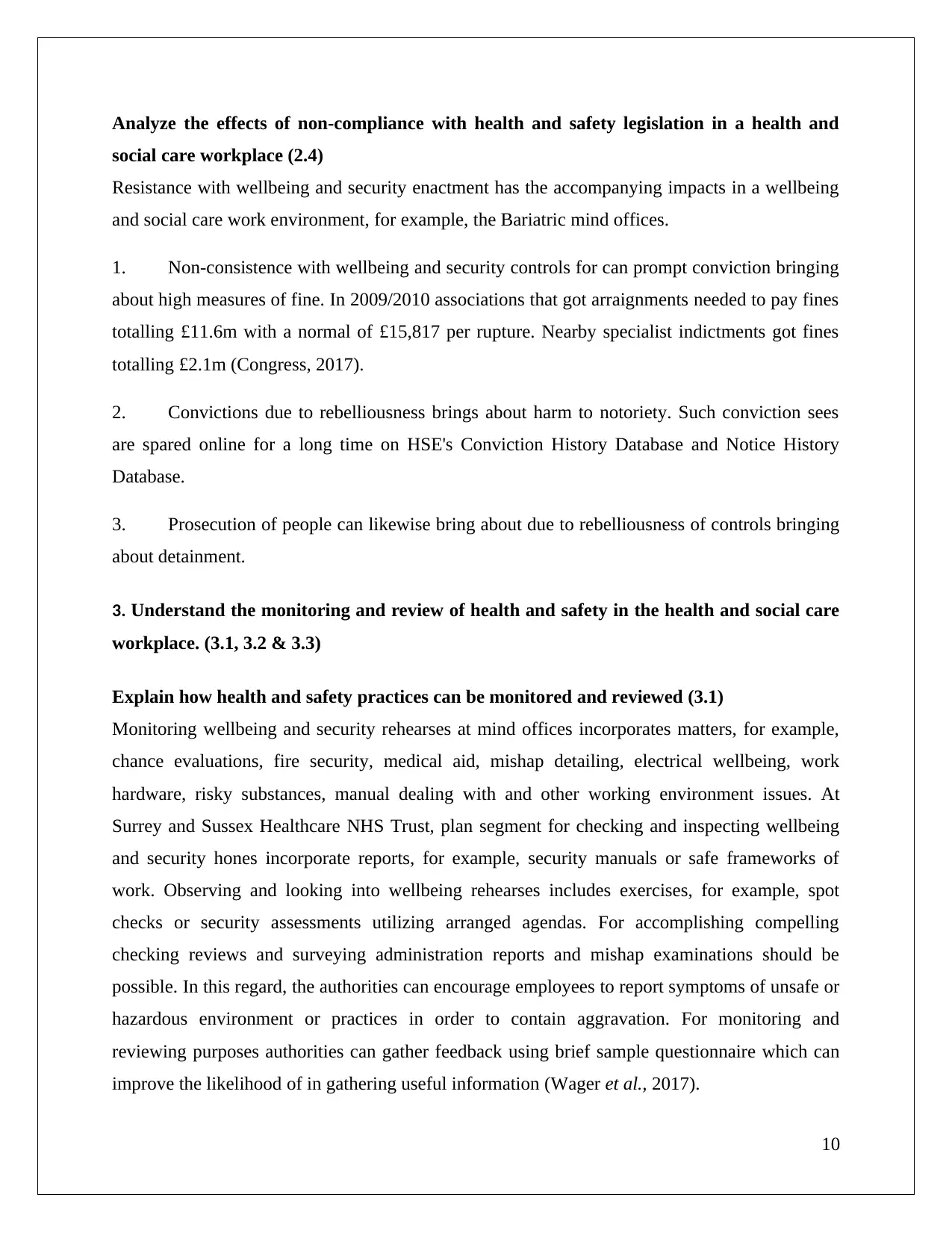
Analyze the effects of non-compliance with health and safety legislation in a health and
social care workplace (2.4)
Resistance with wellbeing and security enactment has the accompanying impacts in a wellbeing
and social care work environment, for example, the Bariatric mind offices.
1. Non-consistence with wellbeing and security controls for can prompt conviction bringing
about high measures of fine. In 2009/2010 associations that got arraignments needed to pay fines
totalling £11.6m with a normal of £15,817 per rupture. Nearby specialist indictments got fines
totalling £2.1m (Congress, 2017).
2. Convictions due to rebelliousness brings about harm to notoriety. Such conviction sees
are spared online for a long time on HSE's Conviction History Database and Notice History
Database.
3. Prosecution of people can likewise bring about due to rebelliousness of controls bringing
about detainment.
3. Understand the monitoring and review of health and safety in the health and social care
workplace. (3.1, 3.2 & 3.3)
Explain how health and safety practices can be monitored and reviewed (3.1)
Monitoring wellbeing and security rehearses at mind offices incorporates matters, for example,
chance evaluations, fire security, medical aid, mishap detailing, electrical wellbeing, work
hardware, risky substances, manual dealing with and other working environment issues. At
Surrey and Sussex Healthcare NHS Trust, plan segment for checking and inspecting wellbeing
and security hones incorporate reports, for example, security manuals or safe frameworks of
work. Observing and looking into wellbeing rehearses includes exercises, for example, spot
checks or security assessments utilizing arranged agendas. For accomplishing compelling
checking reviews and surveying administration reports and mishap examinations should be
possible. In this regard, the authorities can encourage employees to report symptoms of unsafe or
hazardous environment or practices in order to contain aggravation. For monitoring and
reviewing purposes authorities can gather feedback using brief sample questionnaire which can
improve the likelihood of in gathering useful information (Wager et al., 2017).
10
social care workplace (2.4)
Resistance with wellbeing and security enactment has the accompanying impacts in a wellbeing
and social care work environment, for example, the Bariatric mind offices.
1. Non-consistence with wellbeing and security controls for can prompt conviction bringing
about high measures of fine. In 2009/2010 associations that got arraignments needed to pay fines
totalling £11.6m with a normal of £15,817 per rupture. Nearby specialist indictments got fines
totalling £2.1m (Congress, 2017).
2. Convictions due to rebelliousness brings about harm to notoriety. Such conviction sees
are spared online for a long time on HSE's Conviction History Database and Notice History
Database.
3. Prosecution of people can likewise bring about due to rebelliousness of controls bringing
about detainment.
3. Understand the monitoring and review of health and safety in the health and social care
workplace. (3.1, 3.2 & 3.3)
Explain how health and safety practices can be monitored and reviewed (3.1)
Monitoring wellbeing and security rehearses at mind offices incorporates matters, for example,
chance evaluations, fire security, medical aid, mishap detailing, electrical wellbeing, work
hardware, risky substances, manual dealing with and other working environment issues. At
Surrey and Sussex Healthcare NHS Trust, plan segment for checking and inspecting wellbeing
and security hones incorporate reports, for example, security manuals or safe frameworks of
work. Observing and looking into wellbeing rehearses includes exercises, for example, spot
checks or security assessments utilizing arranged agendas. For accomplishing compelling
checking reviews and surveying administration reports and mishap examinations should be
possible. In this regard, the authorities can encourage employees to report symptoms of unsafe or
hazardous environment or practices in order to contain aggravation. For monitoring and
reviewing purposes authorities can gather feedback using brief sample questionnaire which can
improve the likelihood of in gathering useful information (Wager et al., 2017).
10
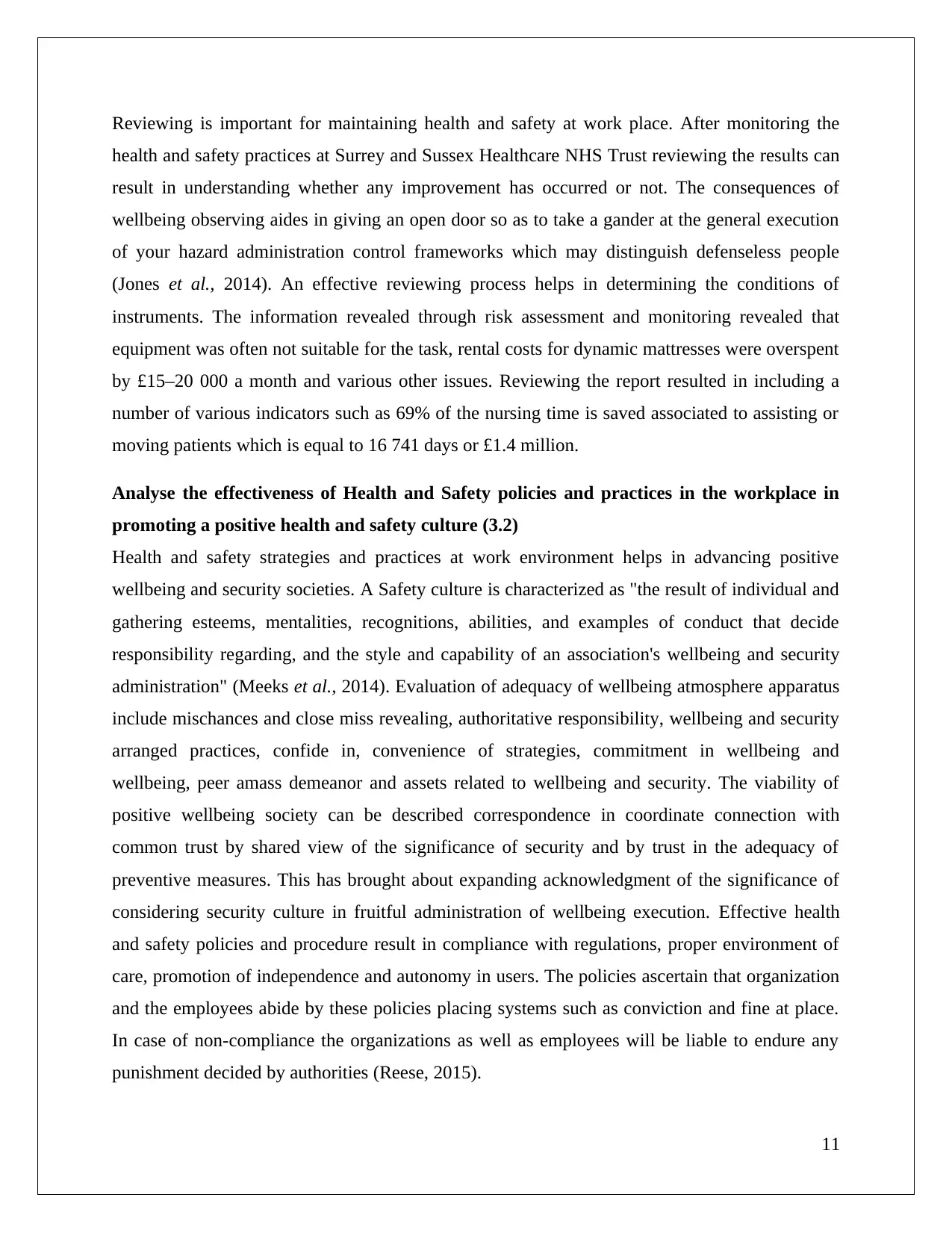
Reviewing is important for maintaining health and safety at work place. After monitoring the
health and safety practices at Surrey and Sussex Healthcare NHS Trust reviewing the results can
result in understanding whether any improvement has occurred or not. The consequences of
wellbeing observing aides in giving an open door so as to take a gander at the general execution
of your hazard administration control frameworks which may distinguish defenseless people
(Jones et al., 2014). An effective reviewing process helps in determining the conditions of
instruments. The information revealed through risk assessment and monitoring revealed that
equipment was often not suitable for the task, rental costs for dynamic mattresses were overspent
by £15–20 000 a month and various other issues. Reviewing the report resulted in including a
number of various indicators such as 69% of the nursing time is saved associated to assisting or
moving patients which is equal to 16 741 days or £1.4 million.
Analyse the effectiveness of Health and Safety policies and practices in the workplace in
promoting a positive health and safety culture (3.2)
Health and safety strategies and practices at work environment helps in advancing positive
wellbeing and security societies. A Safety culture is characterized as "the result of individual and
gathering esteems, mentalities, recognitions, abilities, and examples of conduct that decide
responsibility regarding, and the style and capability of an association's wellbeing and security
administration" (Meeks et al., 2014). Evaluation of adequacy of wellbeing atmosphere apparatus
include mischances and close miss revealing, authoritative responsibility, wellbeing and security
arranged practices, confide in, convenience of strategies, commitment in wellbeing and
wellbeing, peer amass demeanor and assets related to wellbeing and security. The viability of
positive wellbeing society can be described correspondence in coordinate connection with
common trust by shared view of the significance of security and by trust in the adequacy of
preventive measures. This has brought about expanding acknowledgment of the significance of
considering security culture in fruitful administration of wellbeing execution. Effective health
and safety policies and procedure result in compliance with regulations, proper environment of
care, promotion of independence and autonomy in users. The policies ascertain that organization
and the employees abide by these policies placing systems such as conviction and fine at place.
In case of non-compliance the organizations as well as employees will be liable to endure any
punishment decided by authorities (Reese, 2015).
11
health and safety practices at Surrey and Sussex Healthcare NHS Trust reviewing the results can
result in understanding whether any improvement has occurred or not. The consequences of
wellbeing observing aides in giving an open door so as to take a gander at the general execution
of your hazard administration control frameworks which may distinguish defenseless people
(Jones et al., 2014). An effective reviewing process helps in determining the conditions of
instruments. The information revealed through risk assessment and monitoring revealed that
equipment was often not suitable for the task, rental costs for dynamic mattresses were overspent
by £15–20 000 a month and various other issues. Reviewing the report resulted in including a
number of various indicators such as 69% of the nursing time is saved associated to assisting or
moving patients which is equal to 16 741 days or £1.4 million.
Analyse the effectiveness of Health and Safety policies and practices in the workplace in
promoting a positive health and safety culture (3.2)
Health and safety strategies and practices at work environment helps in advancing positive
wellbeing and security societies. A Safety culture is characterized as "the result of individual and
gathering esteems, mentalities, recognitions, abilities, and examples of conduct that decide
responsibility regarding, and the style and capability of an association's wellbeing and security
administration" (Meeks et al., 2014). Evaluation of adequacy of wellbeing atmosphere apparatus
include mischances and close miss revealing, authoritative responsibility, wellbeing and security
arranged practices, confide in, convenience of strategies, commitment in wellbeing and
wellbeing, peer amass demeanor and assets related to wellbeing and security. The viability of
positive wellbeing society can be described correspondence in coordinate connection with
common trust by shared view of the significance of security and by trust in the adequacy of
preventive measures. This has brought about expanding acknowledgment of the significance of
considering security culture in fruitful administration of wellbeing execution. Effective health
and safety policies and procedure result in compliance with regulations, proper environment of
care, promotion of independence and autonomy in users. The policies ascertain that organization
and the employees abide by these policies placing systems such as conviction and fine at place.
In case of non-compliance the organizations as well as employees will be liable to endure any
punishment decided by authorities (Reese, 2015).
11
⊘ This is a preview!⊘
Do you want full access?
Subscribe today to unlock all pages.

Trusted by 1+ million students worldwide
1 out of 16
Related Documents
Your All-in-One AI-Powered Toolkit for Academic Success.
+13062052269
info@desklib.com
Available 24*7 on WhatsApp / Email
![[object Object]](/_next/static/media/star-bottom.7253800d.svg)
Unlock your academic potential
Copyright © 2020–2025 A2Z Services. All Rights Reserved. Developed and managed by ZUCOL.




